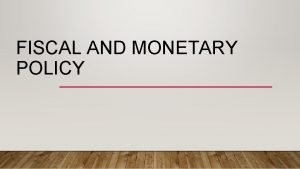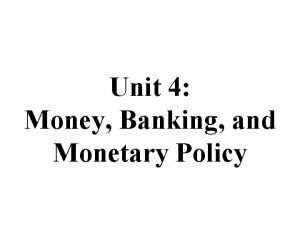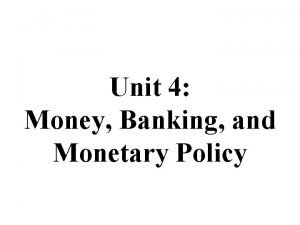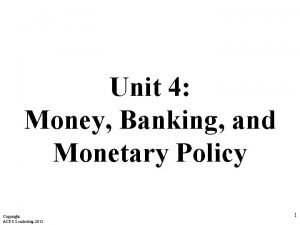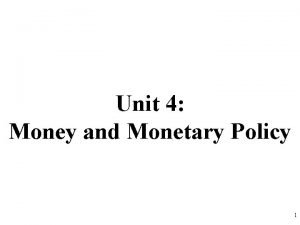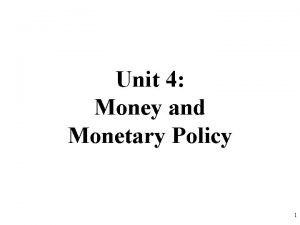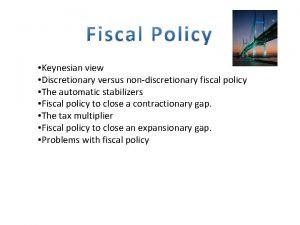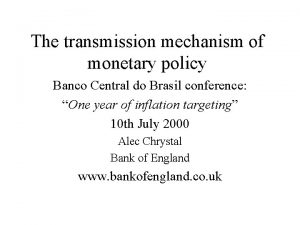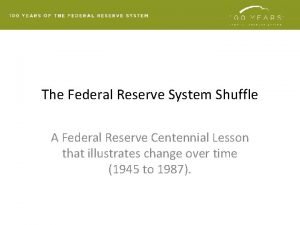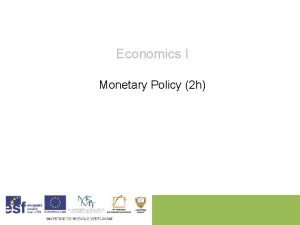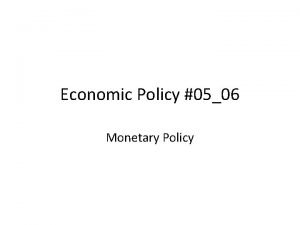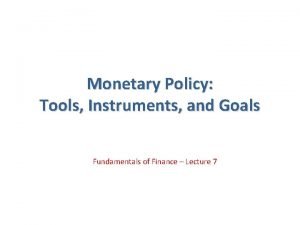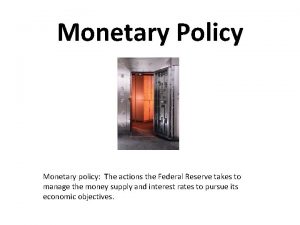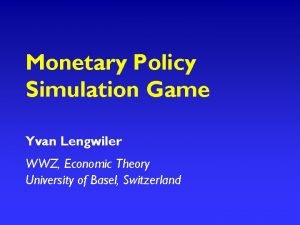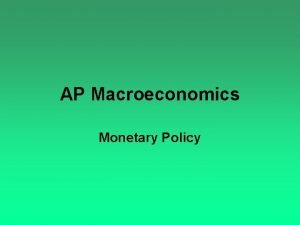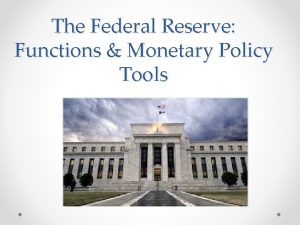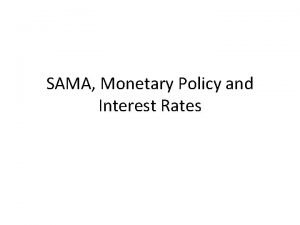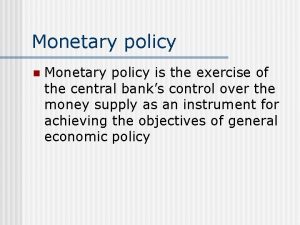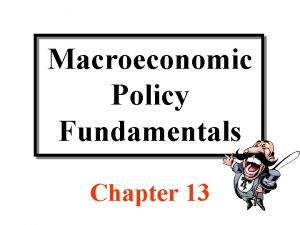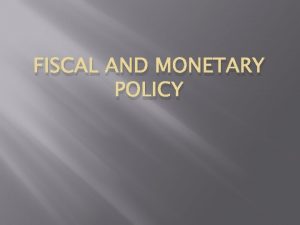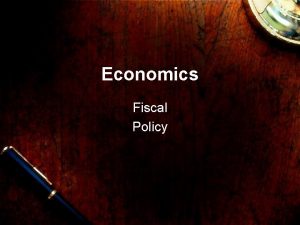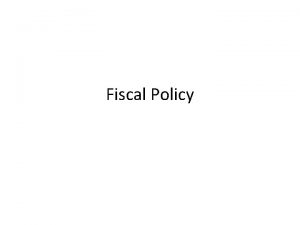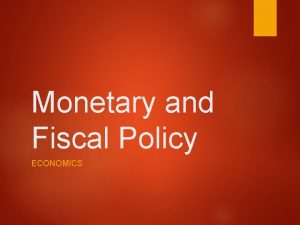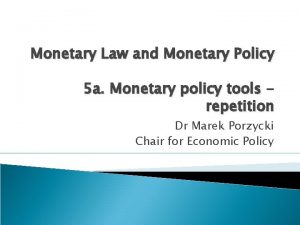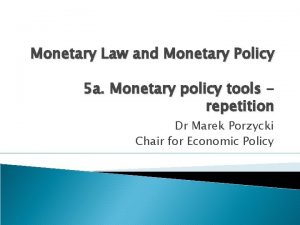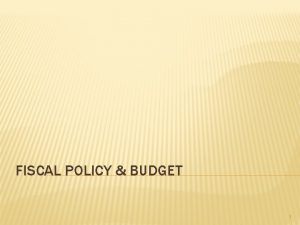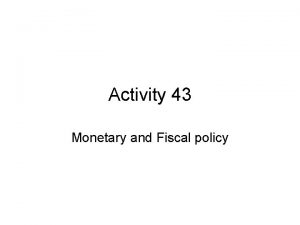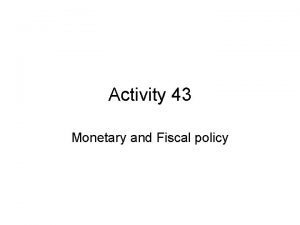The Influence of Monetary and Fiscal Policy on






























- Slides: 30

The Influence of Monetary and Fiscal Policy on Aggregate Demand Copyright © 2010 Cengage Learning 9

Revision • How government deficit and/or tax reduction affects the economic growth in the long run? • Government deficit decreases national saving, income tax reduction increases it while investment tax credit increases investments. • How the money supply controlled by central bank affects the price level in the long run? • According to the quantity theory of money, money supply determines the value of money and is the primary cause of inflation. Copyright © 2010 Cengage Learning

Aggregate Demand • When desired spending changes, aggregate demand shifts, causing short-run fluctuations in output and employment. • Monetary and fiscal policy are sometimes used to offset those shifts and stabilize the economy. • This lecture aims to show: • What is the effect of money supply on the short-run fluctuations of the main macroeconomic variables? • How government spending and tax policy affect economy in the short run? Copyright © 2010 Cengage Learning

Revision • Why the aggregate demand curve slopes downward? • The wealth effect • The interest rate effect • The exchange rate effect Copyright © 2010 Cengage Learning

Why the aggregate demand curve slopes downward? • For a very open economy, such as the UK, the most important reason for the downward slope of the aggregate demand curve is the exchange rate effect. • For a relatively closed economy, such as the US, the most important reason for the downward slope of the aggregate demand curve is the interest rate effect. • In EU, because of the common currency the exchange rate effect is muted. Copyright © 2010 Cengage Learning

The Theory of Liquidity Preference • Keynes developed theory of liquidity preference in order to explain what factors determine the economy’s interest rate. • According to theory, the interest rate adjusts to balance the supply and demand for money. Copyright © 2010 Cengage Learning

Revision • Money Supply • The money supply is controlled by the central bank through: • Open-market operations • Changing the reserve requirements • Changing the refinancing rate • Because it is fixed by the central bank, the quantity of money supplied does not depend on the interest rate. • The fixed money supply is represented by a vertical supply curve. Copyright © 2010 Cengage Learning

The Theory of Liquidity Preference • Money Demand • Money demand is determined by several factors. • According to theory of liquidity preference, one of the most important factors is the interest rate. • People choose to hold money instead of other assets that offer higher rates of return because money can be used to buy goods and services. • The opportunity cost of holding money is the interest that could be earned on interest-earning assets. • An increase in the interest rate raises the opportunity cost of holding money. • As a result, the quantity of money demanded is reduced. Copyright © 2010 Cengage Learning

The Theory of Liquidity Preference • Equilibrium in the Money Market • According to theory of liquidity preference: • The interest rate adjusts to balance the supply and demand for money. • There is one interest rate, called the equilibrium interest rate, at which the quantity of money demanded equals the quantity of money supplied. • Assume the following about the economy: • The price level is stuck at some level. • For any given price level, the interest rate adjusts to balance the supply and demand for money. • The level of output responds to the aggregate demand for goods and services. Copyright © 2010 Cengage Learning

Figure 1 Equilibrium in the Money Market Interest Rate Money supply r 1 Equilibrium interest rate r 2 0 Money demand Md Quantity fixed by the central bank M 2 d Quantity of Money Copyright© 2010 South-Western

The Downward Slope of the Aggregate Demand Curve • The price level is one determinant of the quantity of money demanded. • A higher price level increases the quantity of money demanded for any given interest rate. • Higher money demand leads to a higher interest rate. • The quantity of goods and services demanded falls. • The end result of this analysis is a negative relationship between the price level and the quantity of goods and services demanded. Copyright © 2010 Cengage Learning

Figure 2 The Money Market and the Slope of the Aggregate Demand Curve (a) The Money Market Interest Rate (b) The Aggregate Demand Curve Price Level Money supply 2. . increases the demand for money. . . P 2 r 3. . which increases the equilibrium 0 interest rate. . . Money demand at price level P 2 , MD 2 Money demand at price level P , MD Quantity fixed by the central bank Quantity of Money 1. An P increase in the price level. . . 0 Aggregate demand Y Quantity of Output 4. . which in turn reduces the quantity of goods and services demanded. Y 2 Copyright© 2010 South-Western

Changes in the Money Supply • The central bank can shift the aggregate demand curve when it changes monetary policy. • An increase in the money supply shifts the money supply curve to the right. • Without a change in the money demand curve, the interest rate falls. • Falling interest rates increase the quantity of goods and services demanded. Copyright © 2010 Cengage Learning

Figure 3 A Monetary Injection (b) The Aggregate Demand Curve (a) The Money Market Interest Rate r 2. . the equilibrium interest rate falls. . . Money supply, MS Price Level MS 2 1. When the central bank increases the money supply. . . P r 2 AD 2 Money demand at price level P 0 Quantity of Money Aggregate demand, AD 0 Y Y Quantity of Output 3. . which increases the quantity of goods and services demanded at a given price level. Copyright© 2010 South-Western

Changes in the Money Supply • When the central bank increases the money supply, it lowers the interest rate and increases the quantity of goods and services demanded at any given price level, shifting aggregate demand to the right. • When the central bank contracts the money supply, it raises the interest rate and reduces the quantity of goods and services demanded at any given price level, shifting aggregate demand to the left. Copyright © 2010 Cengage Learning

The Role of Interest Rates • In recent years, many of the major central banks have conducted policy by setting the interest rate at which they will lend to the banking sector (the refinancing rate for the ECB, the repo rate for the Bank of England, and the discount rate in the terms of the US Federal Reserve). • Because changes in the money supply lead to changes in interest rates, monetary policy can be described either in terms of the money supply or in terms of the interest rate. Copyright © 2010 Cengage Learning

Why central banks watch the stock markets (and vice versa) • When the stock market booms, households become wealthier and this stimulates consumer spending. • Rising share prices also make it more attractive for firms to issue new shares and this facilitates increased investment spending. • Central banks can offset these expansionary effects on aggregate demand by keeping the money supply lower and interest rates higher than they otherwise would. • When the stock market falls a central bank needs to loosen monetary policy in order to offset the contractionary effect on aggregate demand. • For example, the decline in the FTSE 100 Index from January 2000 to April/May 2003 is mirrored by a fall in the Bank of England’s Base Rate from 6. 0 per cent to 3. 75 per cent. Copyright © 2010 Cengage Learning

HOW FISCAL POLICY INFLUENCES AGGREGATE DEMAND • Fiscal policy refers to the government’s choices regarding the overall level of government purchases or taxes. • Fiscal policy influences saving, investment, and growth in the long run. • In the short run, fiscal policy primarily affects the aggregate demand. Copyright © 2010 Cengage Learning

Changes in Government Purchases • When policymakers change the money supply or taxes, the effect on aggregate demand is indirect—through the spending decisions of firms or households. • When the government alters its own purchases of goods or services, it shifts the aggregate demand curve directly. • There are two macroeconomic effects from the change in government purchases: • The multiplier effect • The crowding-out effect Copyright © 2010 Cengage Learning

The Multiplier Effect • Government purchases are said to have a multiplier effect on aggregate demand. • Each pound spent by the government can raise the aggregate demand for goods and services by more than a pound. • The multiplier effect refers to the additional shifts in aggregate demand that result when expansionary fiscal policy increases income and thereby increases consumer spending. Copyright © 2010 Cengage Learning

Figure 4 The Multiplier Effect Price Level 2. . but the multiplier effect can amplify the shift in aggregate demand. £ 10 billion AD 3 AD 2 Aggregate demand, AD 1 0 1. An increase in government purchases of £ 10 billion initially increases aggregate demand by £ 10 billion. . . Quantity of Output Copyright© 2010 South-Western

A Formula for the Spending Multiplier • The formula for the multiplier is: Multiplier = 1/(1 - MPC) • An important number in this formula is the marginal propensity to consume (MPC). • It is the fraction of extra income that a household consumes rather than saves. • If the MPC is 3/4, then the multiplier will be: Multiplier = 1/(1 - 3/4) = 4 • In this case, a £ 10 billion increase in government spending generates £ 40 billion of increased demand for goods and services. Copyright © 2010 Cengage Learning

The Crowding-Out Effect • Fiscal policy may not affect the economy as strongly as predicted by the multiplier. • An increase in government purchases causes the interest rate to rise. • A higher interest rate reduces investment spending. • This reduction in demand that results when a fiscal expansion raises the interest rate is called the crowding-out effect. • The crowding-out effect tends to dampen the effects of fiscal policy on aggregate demand. Copyright © 2010 Cengage Learning

Figure 5 The Crowding-Out Effect (a) The Money Market Interest Rate r 2 3. . which increases the equilibrium interest rate. . . (b) The Shift in Aggregate Demand Price Level Money supply 2. . the increase in spending increases money demand. . . £ 10 billion 4. . which in turn partly offsets the initial increase in aggregate demand. AD 2 r AD 3 M D 2 Aggregate demand, AD 1 Money demand, MD 0 Quantity fixed by the central bank Quantity of Money 0 1. When an increase in government purchases increases aggregate demand. . . Quantity of Output Copyright© 2010 South-Western

Changes in Taxes • When the government cuts personal income taxes, it increases households’ take-home pay. • Households save some of this additional income. • Households also spend some of it on consumer goods. • Increased household spending shifts the aggregate demand curve to the right. • The size of the shift in aggregate demand resulting from a tax change is affected by the multiplier and crowding-out effects. • It is also determined by the households’ perceptions about the permanency of the tax change. Copyright © 2010 Cengage Learning

USING POLICY TO STABILIZE THE ECONOMY • Economic stabilization has been an explicit goal of government policy in West European and North American countries since 1945. • The government should respond to changes in the private economy in order to stabilize aggregate demand. • Some economists argue that monetary and fiscal policy destabilizes the economy. • Monetary and fiscal policy affect the economy with a substantial lag. • They suggest the economy should be left to deal with the short-run fluctuations on its own. Copyright © 2010 Cengage Learning

Automatic Stabilizers • Automatic stabilizers are changes in fiscal policy that stimulate aggregate demand when the economy goes into a recession without policy makers having to take any deliberate action. • Automatic stabilizers include the tax system and some forms of government spending. Copyright © 2010 Cengage Learning

Summary • Keynes proposed theory of liquidity preference to explain determinants of the interest rate. • According to this theory, the interest rate adjusts to balance the supply and demand for money. • An increase in the price level raises money demand increases the interest rate. • A higher interest rate reduces investment and, thereby, the quantity of goods and services demanded. • The downward-sloping aggregate demand curve expresses this negative relationship between the price level and the quantity demanded. Copyright © 2010 Cengage Learning

Summary • Policy makers can influence aggregate demand with monetary policy. • An increase in the money supply will ultimately lead to the aggregate demand curve shifting to the right. • A decrease in the money supply will ultimately lead to the aggregate demand curve shifting to the left. • Policymakers can influence aggregate demand with fiscal policy. • An increase in government purchases or a cut in taxes shifts the aggregate demand curve to the right. • A decrease in government purchases or an increase in taxes shifts the aggregate demand curve to the left. Copyright © 2010 Cengage Learning

Summary • When the government alters spending or taxes, the resulting shift in aggregate demand can be larger or smaller than the fiscal change. • The multiplier effect tends to amplify the effects of fiscal policy on aggregate demand. • The crowding-out effect tends to dampen the effects of fiscal policy on aggregate demand. • Economists disagree about how active the government should be in its effort to stabilize the economy. • Advocates say that if the government does not respond the result will be undesirable fluctuations. • Critics argue that attempts at stabilization often turn out destabilizing. Copyright © 2010 Cengage Learning
 Unit 5 macroeconomics lesson 2 activity 45
Unit 5 macroeconomics lesson 2 activity 45 Fiscal vs monetary policy
Fiscal vs monetary policy Unit 4 money banking and monetary policy
Unit 4 money banking and monetary policy Unit 4 money banking and monetary policy
Unit 4 money banking and monetary policy Unit 4 money and monetary policy
Unit 4 money and monetary policy Unit 4 money and monetary policy
Unit 4 money and monetary policy Unit 4 money and monetary policy
Unit 4 money and monetary policy Unit 3 aggregate demand aggregate supply and fiscal policy
Unit 3 aggregate demand aggregate supply and fiscal policy Unit 3 aggregate demand aggregate supply and fiscal policy
Unit 3 aggregate demand aggregate supply and fiscal policy Define non-discretionary fiscal policy
Define non-discretionary fiscal policy Unit 3 aggregate demand aggregate supply and fiscal policy
Unit 3 aggregate demand aggregate supply and fiscal policy Transmission of monetary policy
Transmission of monetary policy Lesson quiz 16-1 monetary policy
Lesson quiz 16-1 monetary policy What are the objectives of monetary policy
What are the objectives of monetary policy Monetary policy
Monetary policy Monetary policy types
Monetary policy types What are the objectives of monetary policy
What are the objectives of monetary policy What are the objectives of monetary policy
What are the objectives of monetary policy What is expansionary monetary policy
What is expansionary monetary policy Policy tools
Policy tools Monetary policy summary
Monetary policy summary Monetary policy simulation game
Monetary policy simulation game Types of monetary policy
Types of monetary policy Instruments of monetary policy
Instruments of monetary policy What is inflation
What is inflation Define moral suasion
Define moral suasion Monetary policy
Monetary policy Sama exchange rate
Sama exchange rate Instruments of monetary policy
Instruments of monetary policy Expansionary monetary policy flow chart
Expansionary monetary policy flow chart Expansionary money policy
Expansionary money policy

